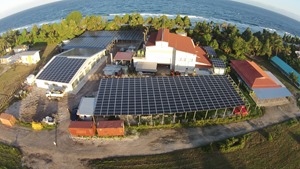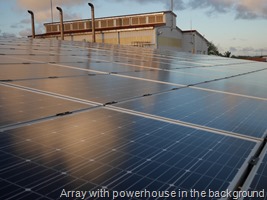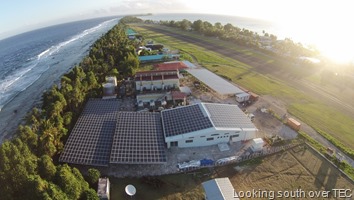
The Solar Space Creation Project in Tuvalu is one of 6 major projects that are changing the face of power generation and supply in Tuvalu in a very short time. The plan is to make the Funafuti electricity grid, and those of several outer islands, run on 100% renewable energy by 2020. Doing this will make us more energy independent, less reliant on terribly unreliable fuel shipments, improve our environment and show that Tuvalu is doing its part to reduce global emissions (despite its minuscule contribution, bearing in mind that Funafuti’s daytime load is about 1,000 kW). The projects in order of installation are:
- Solar Power and Desalination in Funafuti (45 kW) (Russia);
- Solar arrays on the Public Works Department (PWD) (60 kW) and Sports field (40 kW) (Japan);
- Grid connected solar arrays of 170 kW on Funafuti and arrays with battery storage on 4 outer islands that are now close to fully solar (with diesel backup) (Nanumea, Nanumaga, Niutao, Vaitupu) (New Zealand);
- Solar arrays and batteries on Nukufetau, Nukulaelae and Nui which went online earlier this year, close to 100% with diesel backup (EU);
- Funafuti 500 kW systems plus integrated controller (United Arab Emirates) (see also here); and
- Next year the World Bank will further increase Funafuti’s solar coverage up to an anticipated 90%+ including batteries (potentially 800 kW solar + 200 kW wind + batteries). This will also include an upgrade to the control system.
Given the highly-corrosive environment, not all of the older systems were still working so this year they had to be upgraded as part a later project (UAE). There are still challenges for maintenance, trimming of trees and even some signs of vandalism.
The vision and scope of the projects, given the difficulties of remoteness and the harsh environmental conditions, is amazing. At the recent inauguration of the UAE system on 13th of this month, the following statistics (limited to just that project) were given:
- The systems on Funafuti (including arrays at Tuvalu Electricity Corporation (TEC), sportsfield and PWD) were linked and a centralised control system installed to improve the stability of the grid as Funafuti transitions to 100% renewable energy.
- The system has already generated 87 MWhrs of energy that has a CO2 equivalent saving of 61 tonnes of CO2 and 25,000 litres of diesel.
On the outer islands, the results may be even more stark. With fuel supplies a major limiting factor, electricity was often limited to just a few hours per day. With the new NZ systems, islands like Nanumaga now have enough solar space and batteries to tide them over for 5 stormy days before the diesel generators are needed. Fuel is now needed mostly only for keeping the backup generators in good shape (they need to be run from time to time to prevent damage, and they need to be available in case poor weather lasts longer than 5 days in a row). Quality of life on Tuvalu’s outer islands just got an upgrade.


Photos: Clara Mazzone and the pet drone.
